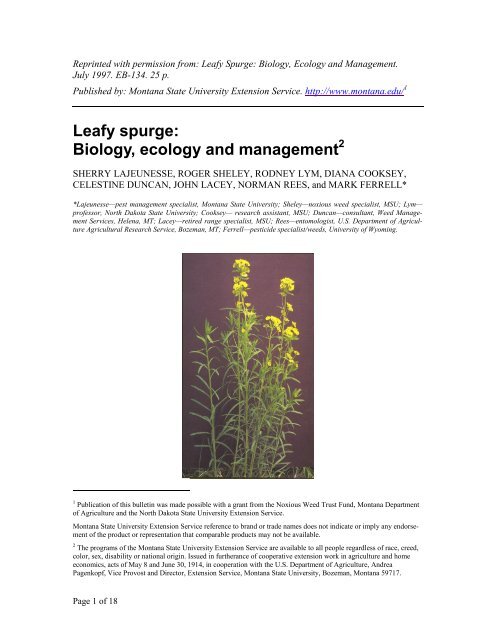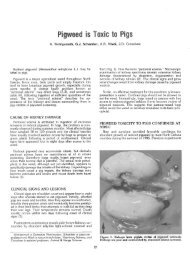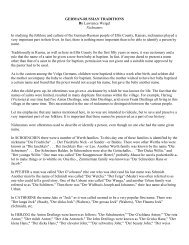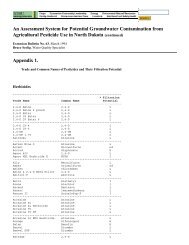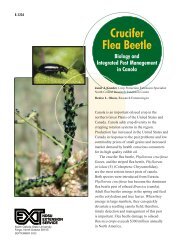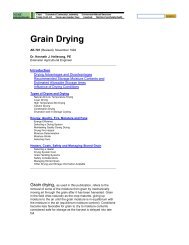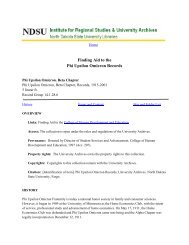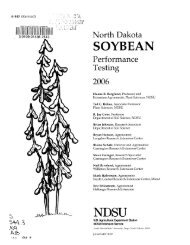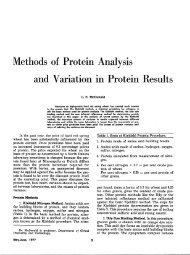Leafy spurge: Biology, ecology and management
Leafy spurge: Biology, ecology and management
Leafy spurge: Biology, ecology and management
You also want an ePaper? Increase the reach of your titles
YUMPU automatically turns print PDFs into web optimized ePapers that Google loves.
Reprinted with permission from: <strong>Leafy</strong> Spurge: <strong>Biology</strong>, Ecology <strong>and</strong> Management.<br />
July 1997. EB-134. 25 p.<br />
Published by: Montana State University Extension Service. http://www.montana.edu/ 1<br />
<strong>Leafy</strong> <strong>spurge</strong>:<br />
<strong>Biology</strong>, <strong>ecology</strong> <strong>and</strong> <strong>management</strong> 2<br />
SHERRY LAJEUNESSE, ROGER SHELEY, RODNEY LYM, DIANA COOKSEY,<br />
CELESTINE DUNCAN, JOHN LACEY, NORMAN REES, <strong>and</strong> MARK FERRELL*<br />
*Lajeunesse—pest <strong>management</strong> specialist, Montana State University; Sheley—noxious weed specialist, MSU; Lym—<br />
professor, North Dakota State University; Cooksey— research assistant, MSU; Duncan—consultant, Weed Management<br />
Services, Helena, MT; Lacey—retired range specialist, MSU; Rees—entomologist, U.S. Department of Agriculture<br />
Agricultural Research Service, Bozeman, MT; Ferrell—pesticide specialist/weeds, University of Wyoming.<br />
1 Publication of this bulletin was made possible with a grant from the Noxious Weed Trust Fund, Montana Department<br />
of Agriculture <strong>and</strong> the North Dakota State University Extension Service.<br />
Montana State University Extension Service reference to br<strong>and</strong> or trade names does not indicate or imply any endorsement<br />
of the product or representation that comparable products may not be available.<br />
2 The programs of the Montana State University Extension Service are available to all people regardless of race, creed,<br />
color, sex, disability or national origin. Issued in furtherance of cooperative extension work in agriculture <strong>and</strong> home<br />
economics, acts of May 8 <strong>and</strong> June 30, 1914, in cooperation with the U.S. Department of Agriculture, Andrea<br />
Pagenkopf, Vice Provost <strong>and</strong> Director, Extension Service, Montana State University, Bozeman, Montana 59717.<br />
Page 1 of 18
<strong>Leafy</strong> <strong>spurge</strong> (Euphorbia<br />
esula L.) is a deep-rooted, longlived<br />
perennial weed that is native<br />
to Eurasia <strong>and</strong> is extremely<br />
difficult to control. In North<br />
America, leafy <strong>spurge</strong> is highly<br />
competitive <strong>and</strong> can displace<br />
native vegetation, often forming<br />
pure st<strong>and</strong>s. Livestock carrying<br />
capacity of infested l<strong>and</strong> is near<br />
zero because forage production<br />
is reduced <strong>and</strong> because cattle<br />
<strong>and</strong> some wildlife will not graze<br />
in infested areas.<br />
Loss of plant diversity, loss<br />
of wildlife habitat, reduction in<br />
l<strong>and</strong> values <strong>and</strong> legal responsibilities for managing the weed are additional liabilities of<br />
leafy <strong>spurge</strong>. <strong>Leafy</strong> <strong>spurge</strong> is also a serious problem in cropl<strong>and</strong>, where herbicide rates<br />
required for effective control are higher than labels permit. Over 2.7 million acres are infested,<br />
mainly in the Northern Great Plains <strong>and</strong> the prairie provinces of Canada. Economic<br />
losses in North Dakota alone exceed $14.4 million per year.<br />
Although leafy <strong>spurge</strong> is spreading rapidly in other areas, including Montana <strong>and</strong><br />
Wyoming, the number of infested acres <strong>and</strong> the rate of spread declined in parts of North<br />
Dakota between 1982 <strong>and</strong> 1992 as a result of intensive <strong>management</strong> efforts. However,<br />
continuing intensive integrated <strong>management</strong> will be necessary to prevent reinvasion <strong>and</strong><br />
to reduce remaining infestations. Control of leafy <strong>spurge</strong> is possible, but only with aggressive<br />
<strong>and</strong> continuing efforts. County weed<br />
offices <strong>and</strong> the Extension service will provide<br />
assistance in designing integrated control programs.<br />
<strong>Biology</strong> <strong>and</strong> <strong>ecology</strong><br />
Identification<br />
Photo: <strong>Leafy</strong> <strong>spurge</strong> is especially troublesome along<br />
waterways since seeds float downstream <strong>and</strong> produce<br />
new infestations.<br />
<strong>Leafy</strong> <strong>spurge</strong> stems are pale green or bluegreen<br />
<strong>and</strong> without hairs. Stems are 16 to 32<br />
inches tall <strong>and</strong> grow in dense patches. The narrow,<br />
hairless leaves are alternate on the stem.<br />
When the plant is injured, a milky latex sap<br />
flows from the injury (Figure 1). The small<br />
flowers are green <strong>and</strong> inconspicuous, but are<br />
surrounded by a pair of yellow-green heartshaped<br />
leaves (bracts) which are often mistaken<br />
for flowers (Figure 2).<br />
Figure 1. <strong>Leafy</strong> <strong>spurge</strong> is distinguished<br />
from plants that are similar in appearance<br />
by a white milky latex which is<br />
present throughout the plant.<br />
Page 2 of 18
Life cycle<br />
<strong>Leafy</strong> <strong>spurge</strong> begins growing in early<br />
spring from buds on the crown (the junction<br />
between root <strong>and</strong> stem) <strong>and</strong> roots (Figure 3), as<br />
well as from seed. New growth from rootstock<br />
usually begins in late April in northern climates,<br />
giving leafy <strong>spurge</strong> a competitive advantage<br />
as one of the first plants to emerge. Peak<br />
period of seed germination is from late May to<br />
early June in northern climates, but some germination<br />
can occur any time adequate moisture<br />
is available.<br />
Yellow-green bracts develop on stems in<br />
May or early June in the northern climates, giving<br />
the plant the appearance of “blooming.”<br />
However, the small, green flowers develop<br />
about two weeks later. Flowering is usually<br />
completed by mid-July. Seeds develop for 20 to<br />
30 days after flowering. (Calendar dates will<br />
vary with climate <strong>and</strong> geographic location.)<br />
<strong>Leafy</strong> <strong>spurge</strong> becomes dormant in some areas<br />
in late summer, but growth can resume in the<br />
fall. Summer dormancy does not occur in some<br />
regions, or in wet, cool years.<br />
Figure 2. The inconspicuous true flowers<br />
of leafy <strong>spurge</strong> are surrounded by<br />
showy yellow-green bracts.<br />
Seeds <strong>and</strong> seedlings<br />
Figure 3. <strong>Leafy</strong> <strong>spurge</strong> roots have numerous<br />
vegetative buds which contribute<br />
to the spread <strong>and</strong> persistence of<br />
the weed.<br />
Each flower produces a lobed capsule containing<br />
three seeds (Figure 4). When the stem<br />
matures, the capsules explode, projecting seeds<br />
up to 15 feet. Each flowering stem produces an<br />
average of 140 seeds. Flowering <strong>and</strong> seed production<br />
can occur throughout the summer if soil moisture is available. Part of each crop<br />
of leafy <strong>spurge</strong> seeds can remain dormant <strong>and</strong> viable for as long as eight years. They remain<br />
dormant even longer if seeds are deeply buried. Temperatures from 68° F to 86° F<br />
are optimum for seed germination.<br />
In the absence of competition, seedling roots can penetrate to a depth of three feet <strong>and</strong><br />
spread laterally 40 inches in four months By the second year, plants are well established<br />
(Figure 5). Seedlings develop stem <strong>and</strong> root buds about 12 days after emergence with<br />
new shoots developing rapidly from these buds if the main shoot is injured or removed.<br />
Seedlings rarely flower the first year.<br />
Page 3 of 18
Figure 4. <strong>Leafy</strong> <strong>spurge</strong> plants have<br />
lobed capsules which contain one to<br />
three seeds. The capsules explode when<br />
dry, projecting seeds up to 15 feet from<br />
the plant.<br />
Figure 5. Root system of a two-year-old leafy<br />
<strong>spurge</strong> plant.<br />
Shoots<br />
Shoots develop from leafy <strong>spurge</strong>’s numerous stem <strong>and</strong> root buds as well as from<br />
seeds. Stem buds cause branching of stems, while new shoots develop from root buds<br />
when older shoots are removed or the crown is damaged (Figure 3).<br />
Roots<br />
The root system is comprised of both vertical <strong>and</strong> horizontal roots. Main vertical roots<br />
can grow to depths of 26 feet. Horizontal roots, which grow near the soil surface, can extend<br />
15 feet per year from the parent plant. Each root bud is capable of producing a new,<br />
independent plant. Root buds have been found at depths of ten feet or more. The depth,<br />
extent <strong>and</strong> thick corky bark of the roots enable leafy <strong>spurge</strong> to survive during periods of<br />
drought, grazing or herbicide applications. The roots contain a large food reserve capable<br />
of sustaining the plant for years <strong>and</strong> can provide the energy needed for new shoots to<br />
emerge from buds after chemical or mechanical treatments. The deep <strong>and</strong> extensive root<br />
system makes leafy <strong>spurge</strong> very difficult to control.<br />
Dispersal<br />
<strong>Leafy</strong> <strong>spurge</strong> seeds are spread several ways. The seeds float on water, often resulting<br />
in new infestations along ditches, rivers <strong>and</strong> in areas that are periodically flooded. Seeds<br />
can be spread by animals in the mud on their feet or are eaten by sheep, goats, rodents or<br />
birds <strong>and</strong> then deposited in dung. Seeds <strong>and</strong> sometimes root pieces are widely spread as<br />
contaminants in crop seed, feed grain or hay <strong>and</strong> on vehicles <strong>and</strong> equipment.<br />
Page 4 of 18
Habitats<br />
<strong>Leafy</strong> <strong>spurge</strong> grows in a variety of habitats ranging from flood plains <strong>and</strong> river banks<br />
to grassl<strong>and</strong>s, ridges <strong>and</strong> mountain slopes. It is found on both dry <strong>and</strong> moist sites <strong>and</strong> in<br />
climates that are either hot or cold. It is found on ab<strong>and</strong>oned cropl<strong>and</strong>, pastures, rangel<strong>and</strong>,<br />
roadsides <strong>and</strong> waste areas, <strong>and</strong> often dominates bottoml<strong>and</strong>s. The weed is found less<br />
frequently on top slope, summit <strong>and</strong> shoulder slopes. The species will thrive on many soil<br />
types, especially after disturbance.<br />
Distribution<br />
<strong>Leafy</strong> <strong>spurge</strong> is found worldwide except in Australia. It has been found as far north as<br />
Sc<strong>and</strong>inavia <strong>and</strong> as far south as Italy <strong>and</strong> Spain. In North America, it is widespread<br />
throughout the United States <strong>and</strong> southern Canada (Figure 6).<br />
Figure 6. Distribution of leafy <strong>spurge</strong> in the United States <strong>and</strong> Canada in 1994. U.S. counties<br />
<strong>and</strong> Canadian census divisions reported presence or absence, not actual infested areas. Local<br />
boundaries shown for the provinces of British Columbia, Alberta, Nova Scotia, New<br />
Brunswick <strong>and</strong> Prince Edward Isl<strong>and</strong> coincide with county or municipality boundaries. Local<br />
boundaries shown for Saskatchewan, Manitoba, Quebec <strong>and</strong> Newfoundl<strong>and</strong> are census<br />
divisions. Data were provided by the USDA-APHIS-PPQ Cooperative Agricultural Pest<br />
Survey (CAPS) <strong>and</strong> Canadian cooperators. Map by Diana Cooksey, Montana State University<br />
Department of Plant, Soil <strong>and</strong> Environmental Sciences.<br />
Page 5 of 18
Management<br />
Successful <strong>management</strong> of leafy <strong>spurge</strong> requires the use of all available control methods.<br />
Preventing invasion by leafy <strong>spurge</strong> is the most effective <strong>management</strong> strategy.<br />
Avoid importation of machinery, feed or livestock that might be carrying leafy <strong>spurge</strong><br />
root pieces or seeds into uninfested areas. Conduct annual, on-the-ground weed searches<br />
to spot any new infestations early, while control is still feasible. Preventing importation<br />
of the weed into uninfested areas as well as monitoring, mapping <strong>and</strong> managing existing<br />
infestations is important in good l<strong>and</strong> stewardship <strong>and</strong> leafy <strong>spurge</strong> control. In many<br />
states, including Montana, North Dakota <strong>and</strong> Wyoming, leafy <strong>spurge</strong> is designated a<br />
“noxious weed,” meaning l<strong>and</strong> owners or managers are legally responsible for its control.<br />
<strong>Leafy</strong> <strong>spurge</strong> control must be considered a long-term <strong>management</strong> program. It is important<br />
to remember that no single <strong>management</strong> practice or treatment will eradicate<br />
this weed. Annual monitoring <strong>and</strong> a combination of control methods is essential. Four<br />
methods are used to manage leafy <strong>spurge</strong>: physical control, plant competition, biological<br />
control <strong>and</strong> chemical control.<br />
Physical control<br />
Physical control of leafy <strong>spurge</strong> is primarily by cultivation. Mowing <strong>and</strong> burning are<br />
also used, but are less successful <strong>and</strong> should be combined with herbicide treatments.<br />
Cultivation<br />
Cultivation is used on cropl<strong>and</strong>, where few other options for control are available.<br />
There are generally two types of tillage programs for leafy <strong>spurge</strong> control: intensive<br />
throughout the growing season <strong>and</strong> fall-only cultivation. Intensive tillage programs<br />
should begin in the spring, two to four weeks after leafy <strong>spurge</strong> emerges. Use a duckfoot<br />
cultivator <strong>and</strong> till four inches deep (Figure 7), repeating every three weeks until the soil<br />
freezes in the fall, for one to two growing seasons. The cultivation schedule should not be<br />
Figure 7. Intensive cultivation will<br />
control leafy <strong>spurge</strong>. However, it is<br />
often not feasible because of rough<br />
terrain <strong>and</strong> soil erosion potential<br />
on rangel<strong>and</strong> sites.<br />
Page 6 of 18
interrupted because leafy <strong>spurge</strong> resprouts quickly. Pieces of roots as small as ½ -inch<br />
long <strong>and</strong> 1/10 -inch diameter may produce new shoots. Care should be taken not to<br />
transport root pieces on machinery into uninfested portions of the field or other areas.<br />
Fall-only cultivation should be done once or twice when leafy <strong>spurge</strong> regrowth is<br />
three to six inches tall for three years. Fall-only cultivation allows crops to be grown during<br />
the season, limits organic matter degradation <strong>and</strong> reduces soil erosion when compared<br />
to season-long cultivation. Cultivation integrated with herbicides enhances leafy <strong>spurge</strong><br />
control. Herbicides such as Roundup ® should be applied at label rates at least seven days<br />
before the first fall cultivation.<br />
Mowing <strong>and</strong> burning<br />
Mowing <strong>and</strong> burning are ineffective for reducing leafy <strong>spurge</strong> infestations, but may<br />
provide uniform regrowth for more effective herbicide treatment. For best control, allow<br />
at least five weeks of regrowth before herbicide application. Mowing will reduce seed<br />
production if repeated every two to four weeks during the growing season, but will provide<br />
little long-term control. Mowing <strong>and</strong>/or herbicide application combined with applications<br />
of nitrogen fertilizer to stimulate grass growth does not control leafy <strong>spurge</strong> better<br />
than herbicides applied alone.<br />
Burning can increase visibility of leafy <strong>spurge</strong> plants <strong>and</strong> can improve herbicide spray<br />
coverage by eliminating old stems <strong>and</strong> ground litter. Burning combined with herbicide<br />
Figure 8. The ten-feet-deep excavation at left shows only a part of a well-established leafy<br />
<strong>spurge</strong> plant’s root system. It is the network of roots close to the surface as shown in Figure<br />
5 that compete with other plants, but these deep roots allow the plant to survive years of<br />
drought.<br />
Page 7 of 18
applications does not increase control, but may reduce leafy <strong>spurge</strong> seed viability. Prescribed<br />
burning can be hazardous <strong>and</strong> should be conducted only by professionally trained<br />
personnel.<br />
Pulling by h<strong>and</strong><br />
Pulling leafy <strong>spurge</strong> by h<strong>and</strong> is usually ineffective, even for small isolated patches,<br />
because of the depth of the root system (Figure 8) <strong>and</strong> the large number of root buds.<br />
However, it may be possible to h<strong>and</strong> pull a few plants that are in their first year of<br />
growth. Early detection <strong>and</strong> h<strong>and</strong> pulling is especially important where control options<br />
are limited, such as in riparian areas.<br />
Plant competition<br />
Some perennial grass species can effectively compete with leafy <strong>spurge</strong>, continually<br />
depriving it of moisture <strong>and</strong> nutrients. Careful <strong>management</strong> of grazing livestock can enhance<br />
the competitiveness of grasses.<br />
Reseeding<br />
Reseeding rangel<strong>and</strong> with a mixture of grass <strong>and</strong> shrub species may provide a more<br />
competitive environment than reseeding with any single species. Plant early-germinating<br />
species to compete with leafy <strong>spurge</strong> seedlings for early season moisture <strong>and</strong> include species<br />
that grow late in the season to compete with fall regrowth of leafy <strong>spurge</strong>. When one<br />
species matures or enters its dormant phase, another should be starting its active growing<br />
phase to continue the competition for moisture <strong>and</strong> nutrients. Where the roots of one species<br />
stop in the soil profile, the roots of another, deeper-rooted species can compete for<br />
deep soil moisture <strong>and</strong> nutrients.<br />
Several grass species have been evaluated for establishment <strong>and</strong> production in leafy<br />
<strong>spurge</strong>-infested areas. The most competitive grasses tested are: ‘Bozoisky’ Russian wildrye<br />
(Psathyrostachys juncea) <strong>and</strong> ‘Luna’ pubescent wheatgrass (Agropyron intermedium<br />
var. trichophorum), both tested successfully in Wyoming; ‘Rebound’ smooth brome<br />
(Bromus inermis), ‘Rodan’ western wheatgrass (Pascopyrum smithii), ‘Manska’ pubescent<br />
wheatgrass <strong>and</strong> ‘Arthur’ Dahurian wildrye (Elymus dahuricas) all tested in North<br />
Dakota; <strong>and</strong> little bluestem (Schizachvrium scoparium), which was evaluated in Minnesota.<br />
The effectiveness of species varies by region, so check with the Natural Resources<br />
Conservation Service (formerly the Soil Conservation Service) for their Plant Materials<br />
Center recommendations of the species best adapted in your area.<br />
Generally, Roundup ® or Roundup ® plus 2,4-D applied once during June <strong>and</strong> repeated<br />
in July will control leafy <strong>spurge</strong> prior to grass seeding, allowing the grasses to establish in<br />
mid-August (Table 1). Timing of seeding will vary depending on location <strong>and</strong> grasses<br />
used, but late summer seeding should be done only when good moisture is available. Late<br />
summer plantings should be done six to eight weeks before a killing frost to allow time<br />
for grasses to properly establish.<br />
Page 8 of 18
Table 1. <strong>Leafy</strong> <strong>spurge</strong> control <strong>and</strong> forage production in Wyoming field trials for two<br />
grass species.<br />
<strong>Leafy</strong> <strong>spurge</strong><br />
control<br />
Number of<br />
grass plants<br />
Production of<br />
air dry grass<br />
Grass species<br />
Grass st<strong>and</strong> 2<br />
(variety) 1 Tilled No-till Tilled No-till Tilled No-till Tilled No-till<br />
Pubescent wheatgrass<br />
(Luna)<br />
% % per 20 ft of row pounds per acre<br />
96 94 99 96 37 28 3245 2670<br />
Russian wildrye<br />
96 80 96 89 54 25 1203 1114<br />
(Bozoisky)<br />
Least significant<br />
difference at 0.05 3 4 4 ns ns 7 7 301 301<br />
1 Grasses seeded August 8, 1989.<br />
2 Evaluations June 22, 1993. Grasses harvested September 28, 1993.<br />
3 Comparison of variety means is valid between tilled <strong>and</strong> no-till.<br />
Grazing <strong>management</strong><br />
Grazing animals can help control leafy <strong>spurge</strong> by increasing the competitiveness of<br />
desirable plants through timing of grazing <strong>and</strong> selective removal of the weed. When<br />
grasses are grazed, they are temporarily weakened <strong>and</strong> plant competition is altered in favor<br />
of leafy <strong>spurge</strong>. Similarly, when leafy <strong>spurge</strong> is grazed, the advantage can shift to the<br />
grasses. Grasses should be grazed when they have produced seedheads or are mature <strong>and</strong><br />
not during periods of active growth. Conversely, leafy <strong>spurge</strong> should be grazed sooner, to<br />
minimize flower <strong>and</strong> seed production. It must be grazed often enough <strong>and</strong> at sufficient<br />
stocking rates to deplete root reserves over time, reducing the competitiveness of the<br />
leafy <strong>spurge</strong>.<br />
Different species of grazing animals select different groups of plants. Combinations<br />
of grazing species can be used to alter plant communities. Cattle tend to prefer grasses<br />
<strong>and</strong> over time forbs (herbaceous, non-woody plants, which includes most weeds) will increase<br />
in a plant community grazed by cattle. In contrast, sheep tend to graze forbs while<br />
goats browse woody plants. Over time, grasses tend to increase in a plant community<br />
grazed by sheep or goats (Figure 9). Elk <strong>and</strong> deer tend to graze grass <strong>and</strong> browse, respectively.<br />
However, each grazing species will use all three groups of plants seasonally, heavily<br />
at times. It is essential to monitor desirable plant species regularly when using grazing<br />
animals to manage leafy <strong>spurge</strong>. Species consumed by sheep or goats will depend on climate,<br />
season, prior dietary experience <strong>and</strong> geography. It may take three to ten years or<br />
even longer, to shift the plant community from leafy <strong>spurge</strong> to grasses—depending on<br />
species, environment <strong>and</strong> other factors (Figure 10). <strong>Leafy</strong> <strong>spurge</strong> will not be completely<br />
eradicated by grazing <strong>management</strong>. Even if sheep or goats are used to graze leafy <strong>spurge</strong>,<br />
grazing <strong>management</strong> must be considered a long-term <strong>management</strong> system to suppress<br />
infestations.<br />
Page 9 of 18
Figure 9. Average dietary overlap<br />
between cattle, sheep <strong>and</strong> goats.<br />
Figure 10. L<strong>and</strong>owners observe the effects of cattle<br />
grazing (right) <strong>and</strong> sheep grazing (left) on l<strong>and</strong> infested<br />
with leafy <strong>spurge</strong>.<br />
Sheep<br />
Generally, sheep graze forbs (including leafy <strong>spurge</strong>) more in spring <strong>and</strong> summer<br />
when plants are young <strong>and</strong> succulent, but will select grasses more in fall <strong>and</strong> winter, competing<br />
more directly with cattle. When leafy <strong>spurge</strong> is grazed, the regrowth is often<br />
succulent <strong>and</strong> sheep will continue to select it into early fall. Dietary overlap between<br />
sheep <strong>and</strong> cattle ranges from about 30 percent during spring <strong>and</strong> summer to 70 percent<br />
during fall <strong>and</strong> winter. If sheep are leased, a contract of at least five years might be necessary<br />
for the project to be feasible for the sheep producer. An intensive grazing system that<br />
includes a minimum of two grazing periods in a season, each followed by a rest period to<br />
allow grass regrowth, is more effective than season-long grazing. Stocking rates vary<br />
with leafy <strong>spurge</strong> density, terrain <strong>and</strong> rainfall. Approximately three to six head per acre of<br />
leafy <strong>spurge</strong> per month (or one to two ewes with lambs per acre per summer) may be sufficient.<br />
Adjust the stocking rate as needed to prevent blooming. Sheep that have not previously<br />
grazed leafy <strong>spurge</strong> may require a five- to ten-day adjustment period.<br />
Sheep have been used with positive results in conjunction with insect biocontrol<br />
agents in the genus Aphthona (the flea beetles). Sheep are grazed once in spring <strong>and</strong><br />
again in fall. This schedule avoids disturbing adult beetles when they are laying eggs <strong>and</strong><br />
feeding.<br />
Keep the following guidelines in mind when controlling leafy <strong>spurge</strong> with sheep:<br />
1. Use rotational grazing strategies that allow leafy <strong>spurge</strong> to be grazed often enough<br />
<strong>and</strong> at sufficient stocking rates to weaken the plant. Grazing periods should be timed to<br />
minimize stress to desirable vegetation, especially during stem growth <strong>and</strong> flowering of<br />
grasses. Monitor desirable plant species regularly.<br />
Page 10 of 18
2. Grazing should begin in early spring when leafy <strong>spurge</strong> plants are two to six<br />
inches tall. Breeding schedules should be timed so lambing is completed by May if ewes<br />
are used in the program. Wethers may also be used – they range farther <strong>and</strong> sometimes<br />
experience fewer problems with predators.<br />
3. Pasture rotations should be scheduled to prevent leafy <strong>spurge</strong> from producing<br />
seed. When “the yellow is gone” (the yellow-green bracts), the sheep can be moved to<br />
other leafy <strong>spurge</strong> patches. Once in late spring <strong>and</strong> again in early fall may be sufficient.<br />
Herders or portable electric fencing may be necessary in many operations.<br />
4. Sheep grazing leafy <strong>spurge</strong> plants which have mature seed should be corralled for<br />
at least a week to pass seeds from their digestive tracts before they are moved to an uninfested<br />
area. Transportation of sheep from leafy <strong>spurge</strong>-infested areas to uninfested areas<br />
should be minimized to prevent transport of seeds in their wool.<br />
5. Check with predator <strong>management</strong> professionals before deciding to use sheep –<br />
losses to predators may offset gains in weed control.<br />
Goats<br />
The relative ability of goats <strong>and</strong> sheep to control leafy <strong>spurge</strong> varies with the kind of<br />
plant community. For example, sheep might be used in areas where preserving woody<br />
vegetation is important. Goats will browse woody species in addition to forbs <strong>and</strong><br />
grasses. Goats are best used in areas where terrain is too rough for sheep or where burrs<br />
or other plant species that are problematic for sheep are plentiful. Monitor desirable species<br />
regularly, especially woody species. Stocking rates vary with terrain, leafy <strong>spurge</strong><br />
density <strong>and</strong> rainfall. Twelve to 16 Angora goats per acre of leafy <strong>spurge</strong> per month or<br />
three to four goats per acre of leafy <strong>spurge</strong> for four months may be sufficient. Although<br />
goats are sometimes better suited to a particular area, they require more <strong>management</strong> than<br />
sheep <strong>and</strong> markets may be more limited. Herbicide application (Tordon ® at one quart +<br />
2,4-D at one quart product per acre) in mid-September following fall grazing by goats has<br />
provided good control. Allow three to four inches regrowth before applying herbicides.<br />
Cattle<br />
Cattle will not graze leafy <strong>spurge</strong> <strong>and</strong> will not control this weed. The milky latex<br />
found in leafy <strong>spurge</strong> is a digestive tract irritant to cattle when ingested <strong>and</strong> contact can<br />
result in lesions around the eyes <strong>and</strong> mouth. Improper timing of grass grazing by cattle<br />
may increase leafy <strong>spurge</strong> infestations. Cattle should graze leafy <strong>spurge</strong>-infested pastures<br />
either before grasses begin their active growing phase or after grasses have produced<br />
seedheads. In programs that include cattle <strong>and</strong> sheep, cattle can harvest the grass before<br />
sheep are placed in the area which will enable sheep to remove leafy <strong>spurge</strong> more quickly<br />
<strong>and</strong> efficiently. Avoid allowing grazing of actively growing grasses in spring. Cattle can<br />
also be allowed to harvest grass late in summer before sheep are placed in the area to<br />
graze leafy <strong>spurge</strong> regrowth.<br />
Page 11 of 18
Biological control<br />
In countries of its origin, leafy <strong>spurge</strong> is a member of the native plant community,<br />
controlled by insects, plant diseases, plant competition, intensive grazing <strong>and</strong> other environmental<br />
factors. These controlling factors were left behind when the weed was transported<br />
to North America, resulting in its unchecked spread. Insects that attack the weed in<br />
its native l<strong>and</strong>s have been collected, tested for feeding preferences <strong>and</strong> released on leafy<br />
<strong>spurge</strong> in North America. Only biological control agents that did not feed on crop <strong>and</strong><br />
ornamental plants in the<br />
feeding preference trials<br />
have been approved for<br />
release in the U.S. <strong>and</strong><br />
Canada. Plant pathogens<br />
that attack leafy <strong>spurge</strong> are<br />
also being tested. These<br />
biological control agents –<br />
or biocontrols, as they are<br />
called – will never completely<br />
eradicate the weed,<br />
but they may reduce weed<br />
populations over a period<br />
of years (Figure 11).<br />
Insect biocontrol<br />
agents<br />
A number of species of<br />
insect biocontrol agents of<br />
leafy <strong>spurge</strong> have been approved<br />
for introduction<br />
into the United States. At<br />
this time, the most effective<br />
<strong>and</strong> well-established<br />
biocontrol agents appear to<br />
be several species of root<strong>and</strong><br />
foliage-feeding beetles<br />
in the genus Aphthona <strong>and</strong><br />
one species of stem- <strong>and</strong><br />
root-boring beetle, Oberea<br />
erythrocephala. Appendix<br />
1 contains information on<br />
biology, habitat requirements,<br />
collection <strong>and</strong> release<br />
suggestions for each<br />
of these biocontrol agents.<br />
Figure 11. Top photo: <strong>Leafy</strong> <strong>spurge</strong> infested site (N-Bar<br />
Ranch, Grass Range, Montana).<br />
Bottom photo: Same site, four years after release of Aphthona<br />
nigriscutis beetles.<br />
Page 12 of 18
Collecting, h<strong>and</strong>ling <strong>and</strong> releasing insects:<br />
The following suggestions may help ensure successful collection <strong>and</strong> establishment of<br />
biocontrol agents:<br />
1. Before collecting biocontrol agents, determine habitat requirements for each species<br />
(Appendix I) <strong>and</strong> locate release sites that meet those requirements. Avoid sites with<br />
high ant <strong>and</strong> grasshopper populations. Insects should be released in areas free from grazing,<br />
herbicide or insecticide applications <strong>and</strong> general traffic. The initial release site should<br />
be protected for up to 10 years; secondary sites may not need as much protection.<br />
Grazing is possible on secondary sites if timed when biocontrol agents are not present on<br />
foliage (Appendix 1).<br />
2. Collections should be made with minimum stress to the insects. Hardy insects<br />
such as beetles can be collected by passing a sweep net through the upper portions of the<br />
leafy <strong>spurge</strong> plants eight or 10 times <strong>and</strong> then dumping the contents into a container.<br />
3. Release biocontrol agents as quickly as possible. If the insects are to be moved<br />
more than 50 miles or held longer than a few hours, the biocontrol agents should be<br />
sorted out so that detrimental or predatory insects, spiders, ants, mites, etc., will not accompany<br />
them to the new location or kill them in transit. The agents should be kept cool<br />
during transport by placing them in a cooler with refrigerated (not frozen) coolant packs.<br />
4. Release biocontrol agents by sprinkling over a small area, usually 10 to 15 square<br />
yards, on a leafy <strong>spurge</strong> infestation of moderate density. Avoid tall, dense st<strong>and</strong>s of plants<br />
that sometimes provide too much shade <strong>and</strong> high humidity. Release insects during the<br />
cool parts of the day.<br />
5. Permits are required to transport biocontrol insects or pathogens across state or<br />
provincial borders. In Montana <strong>and</strong> Wyoming, permits are obtained from the state Department<br />
of Agriculture <strong>and</strong> in North Dakota from the USDA Animal <strong>and</strong> Plant Health<br />
Inspection Service.<br />
Pathogen biocontrol agents<br />
Plant diseases can also be used to manage weeds. Several promising bacteria <strong>and</strong><br />
fungi that attack leafy <strong>spurge</strong> roots, crowns <strong>and</strong> seedlings have been identified <strong>and</strong> are<br />
being investigated. The integration of pathogens with other control methods also is being<br />
investigated.<br />
Chemical control<br />
For best results, chemical control should be used as part of a systems approach for<br />
managing leafy <strong>spurge</strong>. Herbicide treatment programs that use annual applications provide<br />
the best long-term control strategy. Do not skip a year until control reaches 90 percent<br />
or more – otherwise leafy <strong>spurge</strong> will reinfest rapidly (Table 2). For assistance in<br />
selection <strong>and</strong> use of herbicides, contact your county weed supervisor or Extension agent.<br />
Page 13 of 18
Small patches<br />
When leafy <strong>spurge</strong> is confined to<br />
small, well-defined areas, herbicide<br />
treatments should begin immediately to<br />
prevent seed production <strong>and</strong> spread of the<br />
weed. Treat an extra 10 to 15 feet around<br />
leafy <strong>spurge</strong> patches to control spreading<br />
roots <strong>and</strong> seedlings. Neither biological<br />
control nor grazing should be used to<br />
manage small patches because these<br />
methods work slowly, will not prevent<br />
seed production (in the case of biocontrol)<br />
<strong>and</strong> will not eradicate the weed.<br />
When patches are small <strong>and</strong> isolated, it is possible to eradicate them with herbicides.<br />
This effort should be given highest priority. If seeds have been produced the site should<br />
be monitored for a minimum of eight years.<br />
Pasture <strong>and</strong> rangel<strong>and</strong><br />
Table 2. Longevity of leafy <strong>spurge</strong> control<br />
if an infestation is not retreated.<br />
Control 12 months Years without retreatment<br />
after last treatment<br />
1 2 3<br />
––––––––% control ––––––––<br />
95% or more 85 70 < 20<br />
80% 60 < 20 0<br />
70% < 30 0 –<br />
60% 20 0 –<br />
Tordon 22K ® (picloram) is the most effective herbicide for controlling leafy <strong>spurge</strong>.<br />
For small, isolated patches only where annual retreatment is not feasible, Tordon 22K ® at<br />
one gallon of product per acre will give 90 percent or more leafy <strong>spurge</strong> control the first<br />
year after treatment (Table 3). Control will decline gradually to approximately 70 percent<br />
three years after treatment <strong>and</strong> more rapidly thereafter. This application rate is not labeled<br />
for <strong>and</strong> should not be used on large infestations (infestations larger than a half-acre).<br />
Research at North Dakota State University has shown that a cost-effective treatment<br />
for leafy <strong>spurge</strong> control is a tank mix of Tordon 22K ® at one pint per acre combined with<br />
2,4-D (four pounds active ingredient per gallon concentrate), at one quart per acre applied<br />
annually during true flowering, approximately two weeks after appearance of the yellow<br />
bracts (Figure 13). This treatment has provided 85 percent leafy <strong>spurge</strong> control after four<br />
annual applications (Table 3) <strong>and</strong> was the most cost-effective treatment for leafy <strong>spurge</strong>.<br />
Fall application of this treatment may not effectively control leafy <strong>spurge</strong>.<br />
Tordon 22K ® at one quart per acre with 2,4-D at one quart per acre provides greater<br />
control, does not require retreatment as frequently, but is more expensive compared with<br />
Tordon 22K at one pint plus 2,4-D at one quart. This treatment can be applied either during<br />
true flowering or in the fall (Figure 13). An economical <strong>management</strong> option is to apply<br />
Tordon 22K at one quart per acre with 2,4-D at one quart per acre the first year,<br />
followed by Tordon 22K at one pint per acre plus 2,4-D at one quart per acre for three<br />
consecutive years.<br />
Banvel ® (dicamba) may provide intermediate levels of leafy <strong>spurge</strong> control in pastures<br />
<strong>and</strong> rangel<strong>and</strong>, but annual treatments with dicamba are not cost-effective.<br />
Page 14 of 18
Table 3. <strong>Leafy</strong> <strong>spurge</strong> control in pastures <strong>and</strong> rangel<strong>and</strong> with herbicides generally applied<br />
annually, during the true-flower growth stage<br />
Year 1 Years 2-4 Months after initial treatment<br />
Herbicide Rate Herbicide Rate 12 24 36 48<br />
(product/ acre) (product/ acre) (% control)<br />
Tordon 22K 1 quart Tordon 22K 1 quart 65 70 75 90<br />
Tordon 22K 2 quarts –– –– 75 20 0 ––<br />
Tordon 22K 4 quarts –– –– 95 80 75 25<br />
Banvel 2 quarts Banvel 2 quarts 55 85 95 -<br />
2,4-D 1 2 quarts 2,4-D 2 quarts 20 30 35 20<br />
Tordon 22K 1 pint Tordon 22K 1 pint 40 50 40 50<br />
Tordon 22K+<br />
2,4-D<br />
Tordon 22K+<br />
2,4-D<br />
1 pint +<br />
1 quart<br />
1 quart +<br />
1 quart<br />
Roundup +<br />
2,4-D 2 1 pint +<br />
1 pint<br />
Tordon 22K+<br />
2,4-D<br />
Tordon 22K+<br />
2,4-D<br />
Tordon 22K<br />
+2,4-D<br />
1 pint +<br />
1 quart. 50 65 75 85<br />
1 quart +<br />
1 quart 70 75 80 95<br />
1 pint +<br />
1 pint 75 90 –– ––<br />
Roundup 1 quart ––– ––– 80 10 –– ––<br />
1 2,4-D applied twice per year in the spring <strong>and</strong> fall, based on 4 pounds active ingredient/gallon concentrate.<br />
2 Applied during the seed-set growth stage in late June early July.<br />
Roundup ® plus 2,4-D (glyphosate + 2,4-D) will provide season-long leafy <strong>spurge</strong><br />
control, but there is a risk of grass injury, especially when applied in the fall. A single<br />
treatment of one pint Roundup plus one pint 2,4-D per acre applied during early seed-set<br />
growth stage (Figure 13) will provide at least 75 percent leafy <strong>spurge</strong> control with 0 to 10<br />
percent grass injury. This treatment should not be applied to the same area for two<br />
consecutive years because grass injury could be severe. Applications of Roundup with<br />
2,4-D should be followed by Tordon plus 2,4-D during the flowering stage the second<br />
year.<br />
2,4-D ester or amine (four pounds active<br />
ingredient-per-gallon formula) at one quart<br />
per acre will give short-term control of leafy<br />
<strong>spurge</strong> top growth. Forage production can<br />
be increased when this treatment is applied<br />
annually in spring. Higher rates of 2,4-D do<br />
not provide significantly better control.<br />
Figure 13. Susceptibility of leafy <strong>spurge</strong> to<br />
2,4-D, Banvel ® Roundup ® +2,4-D or Tordon<br />
22K ® (solid line) <strong>and</strong> to Roundup ® alone (dotted<br />
line) when applied at various times during<br />
the growing season.<br />
Page 15 of 18
Control in trees<br />
Amine formulations of 2,4-D at one quart per acre may be used to control leafy<br />
<strong>spurge</strong> top growth under trees. Avoid contacting tree foliage <strong>and</strong> green bark of young<br />
trees with either direct spray or spray drift.<br />
Roundup ® at one quart per acre when grasses are dormant may give 80 to 90 percent<br />
leafy <strong>spurge</strong> control. Without retreatment, control drops to about 10 percent the second<br />
year. Treatments made prior to mid-July have not given good leafy <strong>spurge</strong> control.<br />
Roundup ® is non-selective at higher rates <strong>and</strong> will kill grasses <strong>and</strong> other vegetation.<br />
Avoid contacting tree foliage <strong>and</strong> green bark of young trees with either spray or drift.<br />
Roundup ® combined with 2,4-D (one pint each) can be used under trees to control<br />
leafy <strong>spurge</strong> <strong>and</strong> decrease the amount of desirable <strong>and</strong> vegetation injury caused by<br />
Roundup alone. Roundup with 2,4-D can be applied two to four weeks earlier than<br />
Roundup alone to obtain good control.<br />
Control near water<br />
2,4-D formulations labeled for use near water at one quart per acre applied in mid-<br />
June will prevent seedling establishment <strong>and</strong> seed-set. Annual applications are necessary.<br />
Krenite S ® can be used at the rate of 1½ to 2 gallons per acre when leafy <strong>spurge</strong> is at<br />
the true flower growth stage. Results with Krenite S ® may be inconsistent <strong>and</strong> treatment<br />
is expensive.<br />
Rodeo ® at 1½ pints per acre will provide 80 to 90 percent leafy <strong>spurge</strong> control when<br />
applied from mid-July to mid-September. A non-ionic surfactant approved for aquatic<br />
sites should be added to the spray solution for best results. Rodeo ® is non-selective <strong>and</strong><br />
will kill or damage vegetation that is contacted by spray or drift. Follow manufacturer<br />
label recommendations for all herbicides prior to application.<br />
Suggested <strong>management</strong> plan<br />
1. Determine whether leafy <strong>spurge</strong> is present on l<strong>and</strong> you own or manage by conducting<br />
an on-the-ground weed survey. Spot treat, with herbicides, any small, isolated<br />
infestations of leafy <strong>spurge</strong>. Assign high priority to these early detection <strong>and</strong> treatment<br />
activities.<br />
2. Map all infestations, including any that were spot treated. Prioritize infestations<br />
that have potential to spread most rapidly or cause the highest economic or ecological<br />
losses.<br />
3. Prevent movement of the weed from infested areas into areas free of leafy <strong>spurge</strong>.<br />
Consider livestock, feed, seed <strong>and</strong> equipment as potential means of spreading infestations.<br />
Develop strategies to manage existing infestations. Different sites may require different<br />
strategies. Use as many <strong>management</strong> strategies as possible, integrating them in<br />
ways that complement each other. Contain infestations to keep the weed from spreading.<br />
Design a <strong>management</strong> program to gradually eliminate dense infestations while treating<br />
satellite infestations. County weed supervisors <strong>and</strong> county Extension agents can assist<br />
you in designing a <strong>management</strong> program.<br />
Page 16 of 18
4. Manage livestock grazing to increase competitiveness of desirable plants.<br />
5. Monitor <strong>and</strong> remap leafy <strong>spurge</strong> annually to determine the impact <strong>and</strong> effectiveness<br />
of <strong>management</strong> strategies. Adjust strategies based on your findings. Follow-through<br />
is essential for successful <strong>management</strong> of perennial weeds.<br />
6. Keep records to help select economical <strong>and</strong> effective treatments. Records are also<br />
useful to document efforts to meet legal requirements for controlling noxious weeds.<br />
Acknowledgments<br />
Thanks to Bret Olsen, Tom Whitson, Rosie Wall<strong>and</strong>er <strong>and</strong> Bruce Maxwell for manuscript<br />
review.<br />
References<br />
Biesboer, D. D., W. L. Koukkari <strong>and</strong> B. Darveaux. 1993. Controlling leafy <strong>spurge</strong> in Minnesota with competitive<br />
species <strong>and</strong> combined <strong>management</strong> practices. Proceed. Great Plains Ag. Council 14. <strong>Leafy</strong><br />
<strong>spurge</strong> control in the Great Plains. Silver Creek, CO.<br />
Christianson, K. M., R. G. Lym <strong>and</strong> C. G. Messersmith. 1994. Herbicides <strong>and</strong> grass competition for leafy<br />
<strong>spurge</strong> control. Proceed. Great Plains Ag. Council 14. <strong>Leafy</strong> <strong>spurge</strong> control in the Great Plains. Bozeman,<br />
MT. p. 8.<br />
Derscheid, L. A., G. A Wicks <strong>and</strong> W. H. Wallace. 1963. Cropping, cultivation, <strong>and</strong> herbicides to eliminate<br />
leafy <strong>spurge</strong> <strong>and</strong> prevent reinfestation. Weeds 11:105-111.<br />
Ferrell, M. A., T. D. Whitson, D. W. Koch <strong>and</strong> A. E. Gade. 1993. Integrated control of leafy <strong>spurge</strong> (Euphorbia<br />
esula) with Bozoisky Russian wildrye (Psathyrostachys junce) <strong>and</strong> Luna pubescent wheatgrass<br />
(Agropyron intermedium var. trichophorum) 1993. Proceed. West. Soc. Weed Sci. 46:36-38.<br />
Hansen, R. 1994. Phenology of leafy <strong>spurge</strong> biocontrol agents. In: Program Abstracts, <strong>Leafy</strong> Spurge Symposium<br />
1994, p. 13. Bozeman, Montana. 45 pp.<br />
Kirby, D., M. Parman, M. Pessin <strong>and</strong> M. Humann. 1988. Dietary overlap of cattle <strong>and</strong> sheep on rotationally<br />
grazed rangel<strong>and</strong>. SID Res. J. 4:6-11.<br />
Lym, R.G. 1994. Ecology, economic impact, <strong>and</strong> control of leafy <strong>spurge</strong>. Proceedings, Western Section,<br />
American Society of Animal Sciences. Vol. 45. 4 pp.<br />
Lym, R. G. <strong>and</strong> C. G. Messersmith. 1993. Fall cultivation <strong>and</strong> fertilization to reduce winter hardiness of<br />
leafy <strong>spurge</strong> (Euphorbia esula). Weed Science 41:441-446.<br />
Lym, R.G., C.G. Messersmith <strong>and</strong> R. Zollinger. 1993. <strong>Leafy</strong> <strong>spurge</strong> identification <strong>and</strong> control. North Dakota<br />
State University Extension Service, Pub. W-765. 7 pp.<br />
Lym, R.G. <strong>and</strong> R.K. Zollinger. 1995. Integrated <strong>management</strong> of leafy <strong>spurge</strong>. North Dakota State University<br />
Extension Service, Pub. W-866. 4 pp.<br />
Pemberton, R.W. 1988. Myrmecochory in the introduced range weed, leafy <strong>spurge</strong> (Euphorbia esula L.).<br />
Am Midl<strong>and</strong> Nature List 119:431-435.<br />
Scholes, C. M. <strong>and</strong> S. A. Clay. 1994. Evaluation of season-long mechanical <strong>and</strong> low herbicide input treatments<br />
for leafy <strong>spurge</strong> suppression. Proceedings Great Plains Ag. Council<br />
Note: A comprehensive collection of literature on leafy <strong>spurge</strong> is contained on CD-ROM, “Purge Spurge,<br />
<strong>Leafy</strong> Spurge Database”, demo v. 2.5. 1995. USDA Agricultural Research Service in cooperation with<br />
Montana State University- Bozeman, Bozeman, Montana 59717.<br />
Page 17 of 18
Appendix 1. Currently approved insect biocontrol agents – habitat requirements, biology <strong>and</strong> collecting/releasing suggestions.<br />
Insect<br />
Preferred sites<br />
Generations<br />
per year<br />
Location of each life stage<br />
<strong>and</strong> approximate date Plant part affected<br />
Destructive<br />
Stage<br />
Collecting (Stage<br />
<strong>and</strong> Method)<br />
Flea Beetles – Coleoptera: Chrysomelidae<br />
Aphthona<br />
cyparissiae<br />
Warm, open sunny area, mod. One<br />
to light <strong>spurge</strong> density 60% s<strong>and</strong>, One<br />
needle-<strong>and</strong>-thread or porcupine<br />
grasses, flowering <strong>spurge</strong><br />


